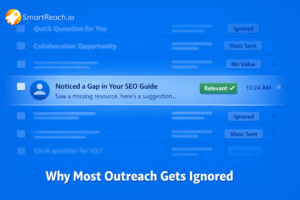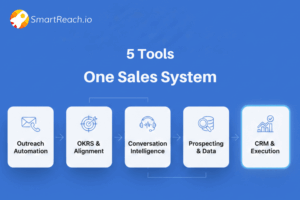Bulk vs Real-Time Email Verification for Cold Outreach
Email deliverability isn’t just about writing good copy or avoiding spam words.
It starts long before you hit send, with the quality of your prospect list.
And one decision sales teams often overlook is when to verify email addresses.
Some prefer to clean their entire list in advance so they know every address is valid.
Others rely on real-time verification tools that check emails at the exact moment messages are sent.
Both methods aim to protect your sender reputation and reduce bounces, but they work in very different ways.
In this blog, we’ll break down how each method works, where each one shines, the trade-offs to watch for, and how modern teams use a mix of both to get the best results.
What is email verification and why does timing matter?
Email verification is the process of checking whether an email address is valid, active, and safe to send to.
It helps you avoid bounces, protect your domain reputation, and ensure your emails actually reach inboxes instead of disappearing into spam.
But it’s not just how you verify that matters – it’s when.
- Verify beforehand (bulk): You clean your entire list before starting the campaign.
- Verify in real time: Each email address is checked at the moment your campaign sends messages.
The timing affects everything, how quickly you can launch campaigns, how accurate your data stays, and how much you spend on verification.
Choosing the right approach depends on how you collect leads and how often your data changes.
Verifying emails beforehand (Bulk verification)
Bulk verification means cleaning your entire email list before you start a campaign.
You upload the list to an email verification tool, remove invalid or risky addresses, and then send only to the verified contacts.
Why teams choose bulk verification?
- Lower risk from day one: You know your email list is clean before sending the first email.
- Protects domain reputation: Fewer bounces mean inbox providers trust you more.
- Ideal for large, static lists: If your list doesn’t change often, one-time cleaning works well.
What to keep in mind?
- It takes extra time before launching campaigns.
- Data can become outdated quickly if your leads change jobs or switch emails.
- You pay to verify the entire list, even if you won’t email every contact.
Note: Bulk verification is best when you’re running big outreach campaigns, working with purchased or older data, or need to meet strict compliance standards.
Recommended read: How to Verify Email Addresses Before Sending Cold Email?
Real-time verification during cold email campaigns
Real-time verification checks each email address at the exact moment your campaign sends messages.
Instead of cleaning the entire list in advance, the system verifies only the contacts you actually reach out to.
Why teams choose real-time verification:\?
- Always up-to-date: You’re verifying emails right before they’re used, which helps when leads change jobs frequently.
- Faster campaign launches: You can start sending immediately without waiting for list cleaning.
- Cost-efficient for dynamic lists: You only pay to verify the addresses you email, not the entire database.
What to keep in mind?
- It depends on integration with a reliable verification service.
- Sending speed may be slightly slower because each address is checked on the fly.
- Costs can add up if your verification provider charges per API call.
Real-time verification is ideal for teams adding new leads every day, using sources like LinkedIn or inbound signups, where data freshness is critical.
Bulk vs. real-time verification: Key scenarios
| Factor | Bulk Verification (Before Campaign) | Real-Time Verification (During Campaign) |
| Data freshness | Can become outdated if leads change jobs | Always current at the time of sending |
| Campaign speed | Slower to launch, since lists must be cleaned first | Instant launch, no waiting period |
| Cost structure | Pay to verify the entire list | Pay only for contacts you email |
| Risk of bounces | Very low at launch, but risk grows as data ages | Consistently low if the API works reliably |
| Best for | Large, static lists or one-time campaigns | Dynamic lead sources, ongoing outreach |
| Setup effort | One-time list cleaning step | Requires API/integration with your outreach tool |
Quick takeaway:
- If you’re running a single big campaign to a static list, bulk verification is safer.
- If you’re adding new leads every day or working with fast-changing data, real-time verification keeps you protected.
Hybrid approach: The best of both worlds
Many sales teams don’t choose between bulk and real-time verification; they use both. This approach combines the security of a clean list with the flexibility of live checks.
How it works:
- Clean your base list upfront to remove obvious invalid or risky emails.
- Enable real-time verification as your campaign runs to catch any new invalid addresses that appear over time.
This way, you protect your domain reputation from the start and stay protected as your data changes.
It’s especially useful for teams that manage both large prospect databases and a steady flow of fresh leads.
With tools like SmartReach.io, you work with pre-verified lists while automatically validating emails before sending your cold email campaigns.
How does SmartReach.io handle email validation?
SmartReach.io makes email validation seamless by building it directly into your cold email workflow.
Every email address in the list is automatically verified through format checks, MX lookups, and SMTP validation before your campaigns send, ensuring only valid prospects receive your messages.

Unlike many tools that charge separately for verification, SmartReach includes unlimited validation at no extra cost.
This not only protects your sender reputation but also saves time and effort by removing the need for external tools.
Combined with other email deliverability features like spam testing, inbox rotation, domain safety limits, and soft-start campaigns, SmartReach.io offers a complete solution to keep your outreach safe and effective.
Try SmartReach FREE for 14 days.
Frequently asked questions
What is email verification in cold email campaigns?
Email verification is the process of checking whether an email address is valid, active, and safe to send to. It helps reduce bounce rates, protect your domain reputation, and improve overall email deliverability.
Should I verify emails before launching my campaign or in real time?
Verify emails beforehand if you’re working with a large, static list. Use real-time verification if your leads change frequently or you’re adding new contacts daily. Many teams combine both methods for maximum protection.
What’s the difference between bulk and real-time email verification?
Bulk verification cleans your entire list before sending, while real-time verification checks each email at the moment your campaign sends messages. Bulk is best for one-time campaigns, real-time is better for dynamic outreach.
Does real-time email verification slow down sending?
Real-time verification can slightly reduce sending speed since each email is checked individually, but with a reliable service, the delay is minimal and worth the improved accuracy.
Does SmartReach.io include email validation?
Yes. SmartReach.io automatically validates email addresses before campaigns send, at no extra cost, helping maintain high deliverability without additional tools.
What is the best method for ensuring authenticity of an email?
Use email verification tools that perform syntax checks, domain (MX) lookups, and SMTP validation. For sensitive cases, add authentication methods like SPF, DKIM, and DMARC to confirm the sender’s legitimacy.
Should you validate email addresses?
Yes. Validating email addresses prevents bounces, protects your domain reputation, and ensures your messages reach real people instead of inactive or fake accounts.
How to validate if an email is real?
You can verify an email by using online email verification services that check if the address exists and can receive mail. Manual methods include sending a test email or checking domain records, but automated tools are faster and more accurate.
What is the best way to validate a legitimate email vs. phishing email?
Check the sender’s domain and email headers for SPF, DKIM, and DMARC authentication results. Legitimate emails usually pass these checks, while phishing emails often fail or use suspicious domains.




